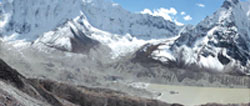|
|
| HOT AND COLD: The Imja Glacier in 1956 and again in 2006. As global warming melts the ice, many new glacial lakes have emerged in the Himalaya, posing an unprecedented threat of flashfloods downstream. |
Scientists are still trying to measure the rate of retreat of Himalayan glaciers, but climbers have known for years that the mountains are melting.
Glacial retreat, receding snowlines and expanding lakes has become much more rapid since the 1980s. Climbing even easy peaks like Cho Oyu and Chomolungma has become harder because previously snow-covered ridges are now bare rock .
Glaciers like the Imja below Lhotse are shrinking by up to 70m per year. There is now a lake 3 km long where there used to a frozen glacier 50 years ago. Dozens of glacial lakes in Nepal and Bhutan are in danger of bursting their banks, and in an earthquake there could be multiple outburst floods on Himalayan rivers.
|
|
There is a near consensus in the scientific community that global warming is caused mainly by carbon emissions from human activity and vegetation loss since the start of the industrial age. The world's biggest emitters of carbon dioxide have not signed up to the Kyoto Protocol to cut back on emissions.
Related Articles
. Himalayan meltdown
. An inconvenient peace prize




